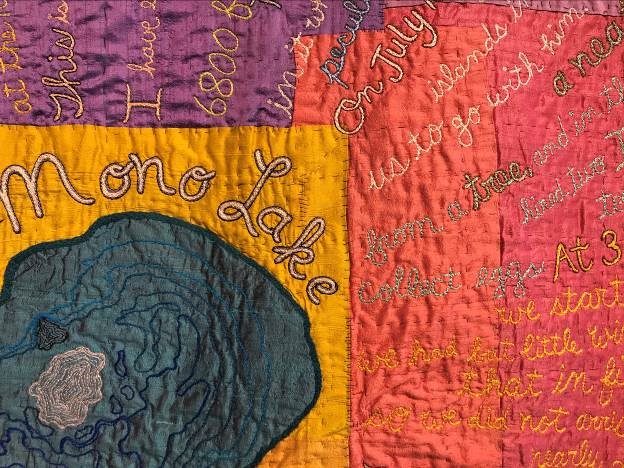Interviewed by Millicent Kennedy
Bonnie Peterson's visually rich quilts and embroideries are currently on display at Evanston Art Center’s Second Floor gallery for her solo exhibition Geoscience Embroidery. I recently had the opportunity to talk to her about her work and what brought her to this textile method of storytelling. She started her journey into quilting when a friend of hers was diagnosed with breast cancer. She quilted together her friend’s bras with poems written by the patient. Peterson was looking to sell the work, using the money to help women who cannot afford to get mammograms. After being declined by several quilting shows, she started to pursue shows at art venues, who were more responsive to this provocative work.

This political edge to Peterson’s work continued with her embroidery work in response to global warming, social and geological issues. Peterson uses residencies and programs that pair her with scientists to gain an in depth knowledge of a variety of regions and translate her gleanings into the work.
Traveling heavily influences her process and she often makes annotated maps of her journeys while on backpacking trips. Though her meticulously made quilts take a significant amount of time to make, she rarely travels with these materials. She prefers to be present and take notes during trips, and make the work when she has returned to her studio in Houghton, Michigan. She has learned how to measure glaciers and track fire patterns, and carries these stories into the quilts. The places that Peterson travels to range widely, and she is more invested in science than a specific region.
In her collaborative efforts with scientists Peterson has found that the artists gain a greater understanding of the topic, while the scientists gain a new perspective on it, thinking of it in a different way. Some of these scientists are part of long term research, measuring variables through time, which makes them a perfect contact to look at future data, and to ask questions.
The linear nature of thread mirrors the graphs and charts of her researching counterparts. While the time that goes into these textiles is reminiscent of the researcher’s long format research projects. She makes all of her work by hand embroidery or with the use of a hand guided sewing machine. Her reflective silks and velvets remind the viewer of water. The wealth of detail draws the viewer closer, allowing them to take in the written text detailing glaciers or the winding Flint, Michigan water situation. Peterson finds significant value in educating her viewers. In the same way that the researchers and scientist are interested in seeking clarity and tracking shifts in their environments, Peterson seeks to pass this information on in a visual format.
View Geoscience Embroidery at The Evanston Art Center through July 30th and learn more HERE.

